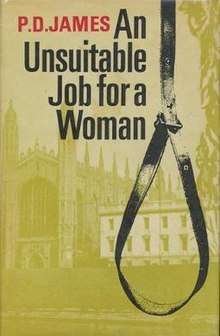An Unsuitable Job for a Woman
An Unsuitable Job for a Woman is the title of a 1972 detective novel by P. D. James and of a TV series of four dramas developed from that novel.
 First edition | |
| Author | P. D. James |
|---|---|
| Country | United Kingdom |
| Language | English |
| Series | Cordelia Gray No. 1 |
| Genre | Mystery novel |
| Publisher | Faber & Faber |
Publication date | 1977 |
| Media type | Print (Hardcover, Paperback) |
| Pages | 287 pp |
| ISBN | 0-446-31517-6 (Paperback edition) |
| OCLC | 31623136 |
| Followed by | The Skull Beneath the Skin |
It features private detective Cordelia Gray, the protagonist of both this title and The Skull Beneath the Skin. Cordelia inherited a detective agency and from there took on her first case.
Plot summary
Young private detective Cordelia Gray walks into the London office she shares with former police detective Bernie Pryde to find her partner has committed suicide. Pryde has left everything, including his unlicensed handgun, to Cordelia, who keeps the failing agency open out of gratitude. When she returns to her office from the funeral service, she is visited by her first client, Elizabeth Leaming, assistant to prominent scientist Sir Ronald Callender, whose son Mark recently died in suspicious circumstances.
Cordelia travels to Cambridge, where Mark had left university despite decent grades and the prospect of a considerable inheritance from his maternal grandfather. She meets Mark's friends, who are reluctant to talk and attempt to convince her that Mark's death was a suicide, as the police investigation had determined.
Cordelia decides to move into the rundown cottage on the estate where Mark had taken a gardening job. As she sifts through Mark's effects, trying to get a clearer picture of his life, she becomes ever more convinced that his death could not have been suicide. Repeatedly, Mark's friends try to lead her away from the investigation but Cordelia is determined to succeed in her first solo case. Returning to the cottage one night and finding an effigy hanging from the same hook on which Mark's body had been suspended only convinces her that foul play was involved.
She finds out that a certain Nanny Pilbeam, formerly nanny to Mark's mother, had attended Mark's cremation and goes to question her. The old woman tells Cordelia that she went to see Mark in his college and gave him a Book of Common Prayer that his mother had wanted him to have when he turned 21. Cordelia finds the book in the cottage, discovering in it evidence that Lady Callender could not have been Mark's mother.
Returning to the cottage the following night, someone attacks Cordelia, throws her down a well, and replaces the cover. She is saved by a combination of her own resourcefulness and the good luck that the cottage owner notices the well has been tampered with. Cordelia in turn lies in wait with Bernie's gun in order to ambush her would-be killer, who turns out to be Sir Ronald's laboratory assistant. However, he escapes in his van, only to die in a collision with a truck. Certain now of her case, Cordelia continues to Sir Ronald's house, where Miss Leaming takes her gun from her and leads her to Sir Ronald. Cordelia privately accuses him of the murder of his son, which he eventually admits, sure that nothing can be proved against him. Miss Leaming, however, who has overheard him, enters the office and shoots him with Cordelia's gun.
Miss Leaming confesses to Cordelia that she was Mark's true mother but was prevented from telling him by Sir Ronald. Lady Callender had been infertile and died shortly after Mark's birth. Sir Ronald had murdered Mark when he was close to discovering the truth, so as not to lose his wife's fortune. Cordelia sympathises with Miss Leaming and the two rearrange the crime scene to look like yet another suicide. The case, however, is referred to Chief Superintendent Adam Dalgliesh, who had originally commanded Bernie Pryde and then sacked him. Word arrives during their interview that Leaming has been killed in a car crash, allowing Cordelia to maintain the fiction they concocted together. Pryde is vindicated posthumously, as Dalgliesh admits to Cordelia, based on his observation of her abilities, that she has been well-trained. In private conference with his superiors, Dalgliesh believes he has worked out the true facts of the case, but says there is little point in disturbing the official story, since everyone involved except Cordelia is now dead.
Cordelia returns to the agency and receives her next client, a man who believes his wife might be cheating on him.
Literary significance and criticism
Jacques Barzun, in his Catalogue of Crime, was unimpressed:
The 22-year-old heroine undertakes, as the surviving partner of a crummy and none-too-credible inquiry agency, to find out why the son of a famous scientist committed suicide. The task brings her to Cambridge, where she gets friendly with a quartet of young people who provide her first lead. After that, all is watching, asking, suffering attack and suspicion, and finally conspiring to conceal crime. In the last few pages Chief Inspector Dalgliesh learns the truth and also keeps it quiet. Barely passable.[1]
Film, TV or theatrical adaptations
The book has been twice adapted. The first adaptation, directed by Chris Petit, was released in UK cinemas in 1982, featuring Pippa Guard as Cordelia. It was financed and produced by Goldcrest Films/ The National Film Finance Corporation and Don Boyd.
A television series starring Helen Baxendale as Cordelia and Annette Crosbie as Edith Sparshott was made in 1997 and 2001, based in part upon the book.
References
- Barzun, Jacques and Taylor, Wendell Hertig. A Catalogue of Crime. New York: Harper & Row. 1971, revised and enlarged edition 1989. ISBN 0-06-015796-8